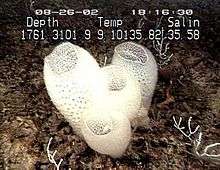Hexactinellid
| Hexactinellid sponges Temporal range: Cambrian–Recent | |
|---|---|
 | |
| "Hexactinellae" from Ernst Haeckel's Kunstformen der Natur, 1904 | |
| Scientific classification | |
| Kingdom: | Animalia |
| Phylum: | "Porifera" |
| Class: | Hexactinellida Schmidt, 1870 |
| Subgroups | |
Hexactinellid sponges are sponges with a skeleton made of four- and/or six-pointed siliceous spicules, often referred to as glass sponges. They are usually classified along with other sponges in the phylum Porifera, but some researchers consider them sufficiently distinct to deserve their own phylum, Symplasma.
Biology


Glass sponges are relatively uncommon and are mostly found at depths from 450 to 900 metres (1,480 to 2,950 ft) although the species Oopsacas minuta has been found in shallow water while others have been found much deeper. They are found in all oceans of the world, although they are particularly common in Antarctic and Northern Pacific waters.[1]
They are more-or-less cup-shaped animals, ranging from 10 to 30 centimetres (3.9 to 11.8 in) in height, with sturdy lattice-like internal skeletons made up of fused spicules of silica. The body is relatively symmetrical, with a large central cavity that, in many species, opens to the outside through a sieve formed from the skeleton. Some species of glass sponges are capable of fusing together to create reefs or bioherms. They are generally pale in colour, ranging from white to orange.[1]
Much of the body is composed of syncitial tissue, extensive regions of multinucleate cytoplasm. In particular, the epidermal cells of other sponges are absent, being replaced by a syncitial net of amoebocytes, through which the spicules penetrate. Unlike other sponges, they do not possess the ability to contract.[1]
One ability they do possess is a unique system for rapidly conducting electrical impulses across their bodies, making it possible for them to respond quickly to external stimuli.[2] Glass sponges like "Venus' Flower Basket" have a tuft of fibers that extends outward like an inverted crown at the base of their skeleton. These fibers are 50 to 175 millimetres (2.0 to 6.9 in) long and about the thickness of a human hair.
Glass sponges are different from other sponges in a variety of other ways. For example, most of the cytoplasm is not divided into separate cells by walls but forms a syncytium or continuous mass of cytoplasm with many nuclei (e.g., Reiswig and Mackie, 1983).

These creatures are long lived, but the exact age is hard to measure; one study based on modelling gave an estimated age of a specimen of Scolymastra joubini as 23,000 years, which is thought impossible,[3] but is the basis for a listing of ~15,000 years in the AnAge Database.[4] The shallow water occurrence of hexactinellids is rare world wide. In the Antarctic two species occur as shallow as 33 meters under the ice. In the Mediterranean one species occurs as shallow as 18 metres (59 ft) in a cave with deep water upwelling (Boury-Esnault & Vacelet (1994))
Reefs
The sponges form reefs off the coast of British Columbia and Washington State,[5] which are studied in the Sponge Reef Project.
Classification

The earliest known hexactinellids are from the earliest Cambrian or late Neoproterozoic. They are fairly common relative to demosponges as fossils, but this is thought to be, at least in part, because their spicules are sturdier than spongin and fossilize better. Like almost all sponges, the hexactinellids draw water in through a series of small pores by the whip like beating of a series of hairs or flagella in chambers which in this group line the sponge wall. (Sponge Gardens)
The class is divided into six orders, in two subclasses:
Class Hexactinellida
- Subclass Amphidiscophora
- Order Amphidiscosida
- Order Amphidiscosa
- Subclass Hexasterophora
- Order Aulocalycoida
- Order Hexactinosa
- Order Lychniscosa
- Order Lyssacinosa
References
| Wikimedia Commons has media related to Hexactinellida. |
| Wikispecies has information related to: Hexactinellida |
- 1 2 3 Barnes, Robert D. (1982). Invertebrate Zoology. Philadelphia, PA: Holt-Saunders International. p. 104. ISBN 0-03-056747-5.
- ↑ Nervous sponge
- ↑ Susanne Gatti (2002). "The Role of Sponges in High-Antarctic Carbon and Silicon Cycling - a Modelling Approach" (PDF). Ber. Polarforsch. Meeresforsch. 434. ISSN 1618-3193. Retrieved 2009-05-25.
- ↑ Hexactinellid information from the AnAge Database
- ↑ Stiffler, Lisa (2007-07-27). "Reef of glass sponges found off Washington's coast". Seattle Post-Intelligencer.